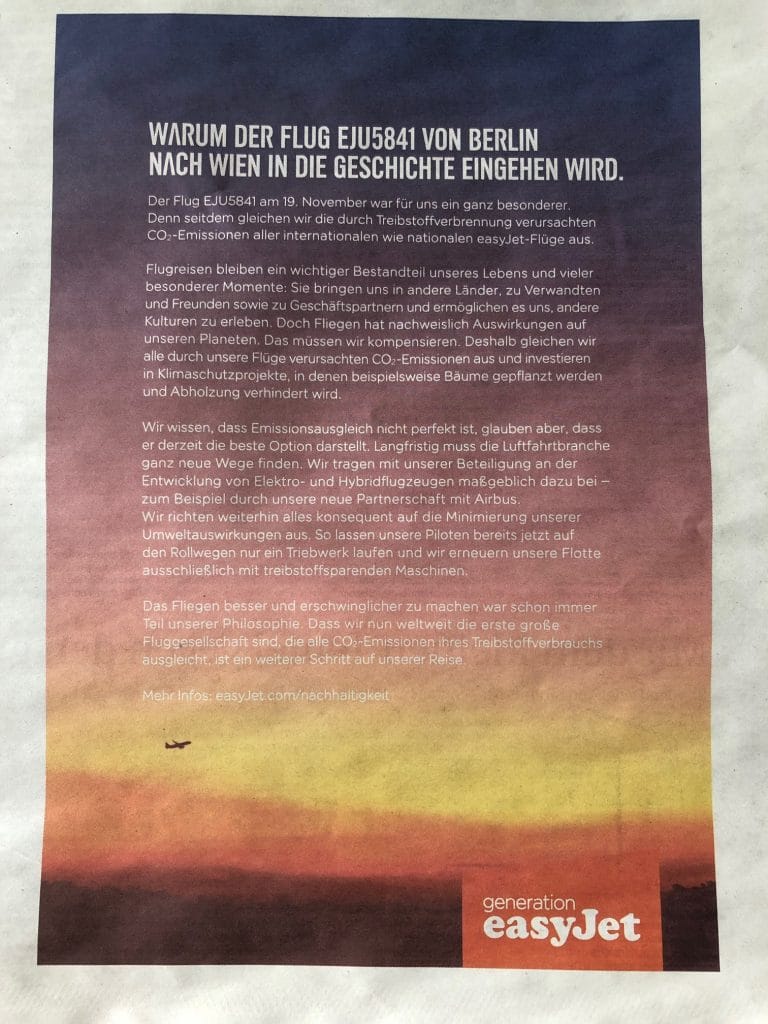Wird Fliegen durch Kompensation klimaneutral?

Fliegen heizt das Klima auf. Schätzungen zufolge tragen die CO2-Emissionen aus dem Luftverkehr, der Ausstoß kurzlebiger Luftschadstoffe wie Stickstoffoxide sowie die Wolkenbildung durch Flugzeuge mehr als fünf Prozent zur globalen Erwärmung bei.
[caption id="attachment_2966" align="alignleft" width="353"] Easy-Jet Werbung Quelle: Privat[/caption]
Easy-Jet Werbung Quelle: Privat[/caption]
Immer mehr Fluggesellschaften und Konsumenten setzen darauf, die Klimawirkung des Fliegens durch Klimaschutzprojekte zu kompensieren. Im November 2019 hat
die britische Fluggesellschaft EasyJet – auch in großformatigen Anzeigen in Tageszeitungen (siehe Foto) – als erste große Fluggesellschaft angekündigt, „die durch Treibstoffverbrennung verursachten CO₂-Emissionen aller nationalen und internationalen Flüge auszugleichen“. Die verwendeten Zertifikate seien durch den Gold Standard oder den Verified Carbon Standard zertifiziert, zwei weltweit anerkannte Standards.
Damit zeigt die Fluggesellschaft deutlich mehr Ambition zum Klimaschutz als die globale Vereinbarung CORSIA. Diese wurde von der Internationalen Zivilluftfahrtorganisation (ICAO) verhandelt und hat lediglich zum Ziel, den Anstieg der CO2-Emissionen über das Niveau von 2019/2020 hinaus zu kompensieren.
Gleichzeitig halten sich die Kosten für EasyJet in Grenzen. Im Gegensatz zu Benzin und Diesel wird Kerosin in der EU nicht besteuert. Setzt man die Kosten für die Kompensation ins Verhältnis zur nicht erhobenen Steuer auf das verbrauchte Kerosin, so würden solche Steuerabgaben etwa 34 Mal so hoch sein wie die Kosten, die für die Kompensation der CO2-Emissionen anfallen: EasyJet rechnet mit etwa 30 Millionen Euro für den Kauf von Kompensationszertifikaten im Jahr 2020. Die nicht erhobene Kerosinsteuer beläuft sich auf etwa 1 Milliarde Euro. Die EU-Energiesteuerrichtlinie gibt einen Mindestsatz von 33 Cent pro Liter Kerosin vor, der im Flugverkehr aber nicht erhoben wird.
Was Kompensationen wirklich wirksam macht
Aber wird das Fliegen durch Kompensieren automatisch klimaneutral? Damit die Kompensation von Treibhausgasemissionen klimaschädliche Effekte tatsächlich ausgleicht, sind folgende Punkte wichtig:
-
Berücksichtigung der „Nicht-CO2 Effekte“: Neben den direkten Emissionen muss auch die Wirkung von Wolkenbildung und anderen chemischen Prozessen berücksichtigt werden. Diese klimaschädlichen Wirkungen werden allerdings durch die Kompensationen allein der CO2-Emissionen nicht
berücksichtigt. Als Daumenregel müsste deshalb die zwei- bis vierfache Menge an Zertifikaten gekauft werden.
-
Zusätzlichkeit: Um eine echte Kompensationswirkung zu erreichen, muss sichergestellt sein, dass die Klimaschutzprojekte nur durch die zusätzlichen Einnahmen aus dem Verkauf von Kompensationszertifikaten ermöglicht werden, und nicht ohnehin umgesetzt werden. In der Praxis ist es nicht einfach, diese „Zusätzlichkeit“ zu gewährleisten. Mehrere Studien haben gezeigt, dass einige Projekte vermutlich sowieso umgesetzt worden wären. Das gilt zum Beispiel auch für einige Wind- und Solarprojekte. Die Kosten für solche Projekte sind stark gesunken und der Ausbau erneuerbarer Energien wird in vielen Ländern durch nationale Politiken vorgeschrieben oder gefördert. Deshalb sind viele Projekte auch ohne die Einnahmen aus Kompensationszertifikaten wirtschaftlich.
-
Vermeidung von Doppelzählung: Die Programme, die Kompensationszertifikate anbieten, müssen sicherstellen, dass die Emissionsreduktionen nicht einerseits vom Land selbst zum Erreichen seiner Klimaschutzziele verwendet und gleichzeitig an private oder staatliche Akteure zur Kompensation ihrer Emissionen verkauft werden.
-
Vorsicht bei Altprojekten: Der Kauf von Kompensationszertifikaten aus alten, bestehenden Projekten hat nicht immer eine Klimawirkung. Um eine Klimawirkung sicherzustellen, sollten nur neue Projekte finanziert werden oder solche, die für ihren Weiterbetrieb auf die Einnahmen aus Zertifikaten angewiesen sind.
Vorsicht bei bestimmten Waldprojekten: Kompensationsprojekte zur Vermeidung von Entwaldung bergen Risiken, die bisher nicht hinreichend adressiert wurden, weil sich die Entwaldung zum Beispiel schlicht von einer Region in eine andere oder ein anderes Land verlagern kann (Leakage).
Welche Rolle kann Kompensation in Zukunft spielen?
Grundsätzlich ist Kompensation nur eine kurz- oder mittelfristige Maßnahme, um Fliegen weniger klimaschädlich zu gestalten. Sie ändert nichts daran, dass die Flugzeuge weiterhin klimaschädliche Emissionen ausstoßen. Um das 1,5-Grad-Ziel erreichen zu können, müssen laut Weltklimarat (IPCC) die globalen Treibhausgasemissionen in den nächsten Jahrzehnten auf Netto-Null verringert werden. Dies bedeutet, dass jede vermeidbare Emission vermieden werden muss. Verbliebene Emissionen müssen durch die Erhöhung von Senken, die die verbleibenden Treibhausgase aufnehmen, ausgeglichen werden.
Unser Fazit: Die Kompensation von Emissionen ist besser als keine Kompensation, aber nur, wenn mehrere Voraussetzungen erfüllt sind und wenn dadurch die Zahl der Flüge nicht steigt. Noch besser für das Klima ist es, gar nicht erst zu fliegen.
Dr. Martin Cames, Jakob Graichen, Dr. Lambert Schneider und Anne Siemons sind Wissenschaftlerinnen und Wissenschaftler im Bereich „Energie und Klimaschutz“ und beschäftigen sich unter anderem mit den Themen Luftverkehr und Klimaschutz.
English version
Can flying be made climate-neutral through compensations?
[caption id="attachment_3786" align="alignnone" width="1024"] Wird Fliegen durch Kompensation klimaneutral? Quelle: Ilja C.Hendel[/caption]
Wird Fliegen durch Kompensation klimaneutral? Quelle: Ilja C.Hendel[/caption]
Flying heats up the climate. It is estimated that the CO2 emissions of air transport, the output of short-lived air pollutants such as nitrogen oxides, and the cloud formation resulting from the aircraft account for more than five percent of global warming.
Airline companies and consumers are becoming more and more conscious of the problem and are focusing on compensating for the environmental impact of flying through investments in climate protection projects. In November 2019, the British airline company EasyJet was the first major airline company to announce that it would compensate CO₂ emissions caused by fuel combustion on all national and international flights (they took out full-page adverts in daily newspapers, see image). The offsets used are the Gold Standard and the Verified Carbon Standard, two globally recognized standards.
By doing so, the airline company clearly showed more ambition with regard to climate protection than was shown in the making of the global agreement CORSIA. This agreement was negotiated by the International Civil Aviation Organization (ICAO) and has the sole aim of compensating for an increase in CO2 emissions beyond the 2019/2020 level.
Meanwhile, the costs arising for EasyJet are staying within limits. Unlike petrol and diesel, kerosene is not taxed in the EU.
By setting the cost of compensation in relation to a tax levied on the kerosene consumed, such taxes would be about 34 times higher than the current taxes only accounting for the cost of compensating for CO2 emissions: EasyJet expects to spend about 30 million euros on the purchase of offset certificates in 2020, while the uncollected kerosene tax would bring in about 1 billion euros. The EU energy tax directive stipulates a minimum rate of 33 cents per litre of kerosene, which has not yet been applied to air transport.
What makes compensations truly effective?
Do compensations automatically make flying climate-neutral? For the compensation of greenhouse gas emissions to balance negative impacts on the environment, one should watch out for the following:
Consideration of the "non-CO2" effects: In addition to direct emissions of flights, the effects of cloud formation and other chemical processes must also be taken into account. However, these climate-damaging effects are not integrated in calculations of CO2 emission compensation. As a rule of thumb, therefore, two to four times the number of certificates should be purchased.
-
Additionality: In order for compensations to have a real impact, one must make sure that the climate protection projects that are funded through the additional revenue from the sale of carbon offsets, were only made possible with that additional revenue. In practice, it is not easy to ensure this so-called "additionality". Several studies have shown that some projects would probably have been realised anyway. This, for instance, has been the case with several wind and solar projects. The costs of such projects have fallen drastically, and the expansion of renewable energies is prescribed or encouraged by national policies in many countries. Therefore, many projects are economically viable even without the income from offsets.
-
Avoiding double counting: Programmes offering carbon offsets must ensure that emission reductions are not, on the one hand, used by the country itself to achieve its climate protection goals and, on the other hand, sold to private or state actors to balance their own emissions.
-
Caution with old projects: Buying offsets connected to old, existing projects does not always have an impact on the climate. In order to ensure an environmental impact, only new projects should be financed or those that depend on the income from certificates for their continued operation.
-
Caution with certain forestry projects: Compensation projects to prevent deforestation entail risks that have not been adequately addressed to date. This is, for instance, due to deforestation simply being able to spread or move from one region to another or to another country (leakage).
What role can compensations play in the future?
Generally, compensations are only short- or medium-term measures to make flying less harmful to the climate. They do not make up for the fact that aircrafts continue to emit climate-damaging emissions. According to the Intergovernmental Panel on Climate Change (IPCC), global greenhouse gas emissions must be reduced to net zero over the next few decades in order to achieve the 1.5-degree target. This means that every avoidable emission must be avoided. The remaining emissions must then be accounted for by increasing sinks that absorb the remaining greenhouse gases.
Our conclusion: attempting to offset emissions is better than no compensation at all, but only if a multitude of conditions are met and if the number of flights does not increase as a result. The most climate-neutral option is still simply not flying at all.
Dr. Martin Cames, Jakob Graichen, Dr. Lambert Schneider and Anne Siemons
are senior researchers in the "Energy and Climate Protection" division. They are experts on such research areas as air transport and climate protection.
